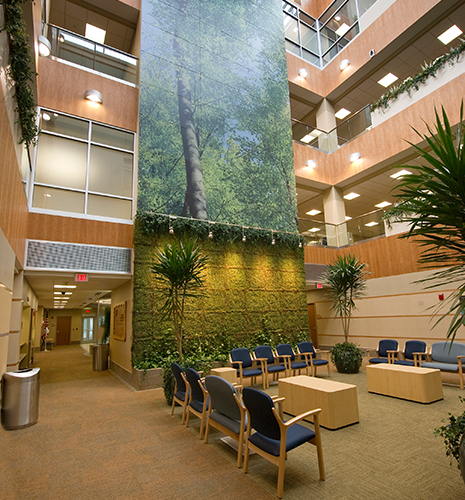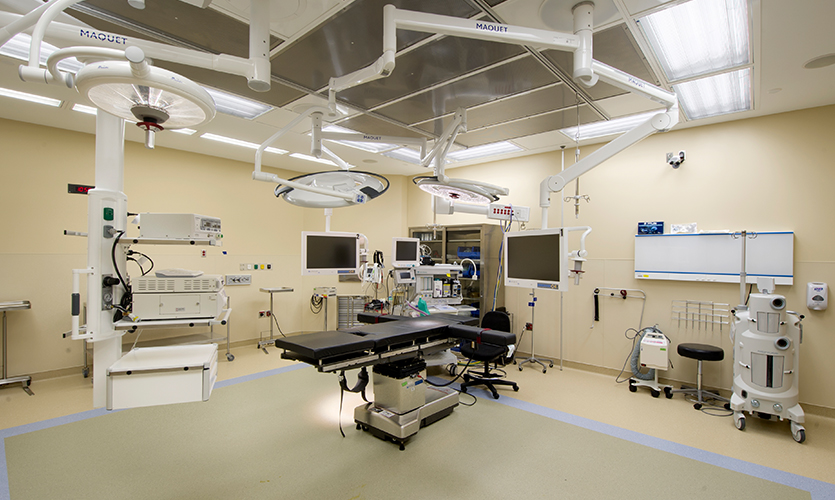Replace-in-Place Hospital
Community Hospitals and Wellness Centers

Projects > Replace-in-Place Hospital
Community Hospitals and Wellness Centers
A small, rural community with a strong sense of history, community pride, and support retained SSOE to program and design an on-site replacement for its only hospital. The new Bryan Hospital replaces the existing facility, which was composed of several buildings of varying ages and conditions, none of which met contemporary standards. SSOE’s design supports 60 beds with capacity for expansion to 100. The hospital has been developed according to LEED® principles.
The main project challenge was to replace the outdated, existing facility, which SSOE addressed by proposing a phased demolition and construction plan. The first phase includes construction of a new energy plant, allowing the remaining hospital wing to be reconnected followed by the integration of new components in stages. The hospital includes leased clinic and shell space for future expansion.
Use of BIM was key in our team’s ability to meet the aggressive project schedule and satisfy budgetary constraints. Since 3D imaging allowed quick representation of the proposed design elements for the owner’s review and approval, BIM became the consummate coordination tool. Used to identify potential conflicts such as slab edge coordination, cross bracing, and major duct runs, BIM virtually eliminated problems with dimension strings. The interrelationship of project data allowed for rapid decision making and quality control review. BIM also easily accommodated any last minute owner modifications.
Featured improvements included new surgery, emergency, intensive care unit, laboratory, obstetrics, recladding of existing facility, new lobby / entry, and complete site work.



 Cancer Center
Cancer CenterAutodesk Construction Cloud (ACC) is SSOE’s enterprise-wide project delivery platform. We partner with the Autodesk Product team and have research access. Use of the AI Assistant allows our design teams, owners, and general contractors the ability to query the project specifications for quality, answers, and more rapid responses to RFIs, submittals, or issues.
SSOE has developed a proof-of-concept to use an AI Agent to act as a Master Engineer and Architect trained in SSOE’s processes, best-known-methods, and trainings. Our data structure is being remodeled to enable better use of our proprietary knowledge to train the agent on the ‘SSOE way’.
SSOE is actively piloting AI Chat large language models (LLMs) or copilots that use Natural Language Processing (NLP) to streamline both design and development tasks, transforming how our teams interact with software and each other.
By integrating chat LLM engines into platforms like Revit, we’re enabling users to prompt complex actions using simple, conversational commands. In Revit, this means automating tasks such as modeling elements, cleaning up parameter data, managing annotations and dimensions, and organizing sheets—without writing scripts. These automations and quality prompts can be shared across project teams, accelerating workflows and reducing manual effort.
Similarly, our internal Software Development Community is leveraging GitHub Copilot to expedite coding tasks. Developers can generate and refine code using NLP prompts, tapping into GitHub’s extensive Repo to move faster from concept to implementation.
Together, these tools represent a shift from traditional, expert-driven scripting to intuitive, AI-assisted automation, unlocking new levels of efficiency and scalability across our projects.
We helped our client visualize and optimize façade design for occupant comfort—long before breaking ground through the use of the Autodesk Forma tool. It allows the designer to rapidly experiment with the building’s geometry and façade design to promote sustainability, prioritizing quality of spaces and comfort for end uses, especially in extreme climates (daylighting and microclimate analysis tools) at the project’s exact geographic location, using location-specific environmental data.
Discover how SSOE is using Autodesk Forma to improve sustainability outcomes for industrial projects: SSOE Group: Improving sustainability outcomes for industrial projects with Autodesk Forma.
SSOE is utilizing Microsoft Copilot Edge and M365 to significantly enhance work efficiency and accuracy across various departments. Copilot is accessible to all staff after training. Key areas of application include using it as a writing assistant, for idea generation, document summarization and generation, research assistant, excel assistant, programming code assistant, language translations, product comparison and data analysis. Use of Copilot has become part of the everyday life of SSOE employees who have identified key ways it can help them become more efficient with their daily tasks as well as more accurate in their deliverables.
Today, 100% of SSOE employees have taken the voluntary training and have access to Copilot Edge, achieving early our October 1, 2025 goal.
We found ourselves in need of a more robust tool to enhance resource forecasting and staff assignment capabilities. Instead of waiting for the perfect tool, we’re building it. SSOE’s in-house technology team has developed and piloted a tool that aims to forecast optimal staff mix and duration for new projects against existing workload to better understand capacity and manage resources efficiently. Additionally, the tool will allow teams to identify gaps to optimal staff mix.